Bibliometric Analysis of Renewable Natural Gas (Biomethane) and Overview of Application in Brazil
Abstract
:1. Introduction
2. Bibliometric Search Analysis
2.1. Bibliometric Database Training
2.2. Results
3. Biomethane in Brazil
3.1. Overview
- ANP Resolution No. 886/2022—Establishes the specification and rules for approving the quality control of biomethane from landfills and sewage treatment plants intended for vehicular use and residential, industrial and commercial installations, to be sold in national territory.
- ANP Resolution No. 906/2022—Provides for the specifications of biomethane from agroforestry and commercial organic products and waste intended for vehicular use and residential and commercial installations to be sold throughout the national territory.
3.2. Economic Aspects
4. Conclusions
- Number of publications per year considering the first level of articles researched;
- The increase in the number of publications per year over the last 10 years;
- Number of documents published per author;
- Number of citations per author;
- Distribution of scientific publications by subject area;
- Number of publications by journal with more than four publications;
- Number of publications by country;
- Percentage of publications by country;
- Co-occurrence network of keywords (at least five occurrences);
- Details of the network of keywords (at least five occurrences) showing the links between the keyword biomethane and the other clusters.
Author Contributions
Funding
Data Availability Statement
Acknowledgments
Conflicts of Interest
References
- Faisal, S.; Ebaid, R.; Li, L.; Zhao, F.; Wang, Q.; Huang, J.; Abomohra, A. Enhanced waste hot-pot oil (WHPO) anaerobic digestion for biomethane production: Mechanism and dynamics of fatty acids conversion. Chemosphere 2022, 307, 135955. [Google Scholar] [CrossRef] [PubMed]
- Nandala, S.P.; Tallam, A.; Choudhary, N.R.; Sundergopal, S.; Bhargava, S.K. Design and optimization of multilayer composite membrane for biomethane enrichment: Process simulations and economics. Sep. Purif. Technol. 2023, 319, 124073. [Google Scholar] [CrossRef]
- Abdul Hameed, N.; Kurien, C.; Kaipakam Jaychandra, R.; Mittal, M. Effect of biomethane substitution on combustion noise and performance of a dual fuel common rail direct injection diesel engine. Environ. Prog Sustain. Energy 2022, 41, e13915. [Google Scholar] [CrossRef]
- Memetova, A.; Tyagi, I.; Karri, R.R.; Kumar, V.; Tyagi, K.; Suhas; Memetov, N.; Zelenin, A.; Pasko, T.; Gerasimova, A.; et al. Porous carbon-based material as a sustainable alternative for the storage of natural gas (methane) and biogas (biomethane): A review. Chem. Eng. J. 2022, 446, 137373. [Google Scholar] [CrossRef]
- Daldrup-Link, H.E. Writing a review article—Are you making these mistakes? Nanotheranostics 2018, 2, 197–200. [Google Scholar] [CrossRef] [PubMed]
- Wang, H.; Maiyalagan, T.; Wang, X. Review on Recent Progress in Nitrogen-Doped Graphene: Synthesis, Characterization, and Its Potential Applications. ACS Catal. 2012, 2, 781–794. [Google Scholar] [CrossRef]
- dos Santos, V.A.; da Silva, P.P.; Serrano, L.M.V. The Maritime Sector and Its Problematic Decarbonization: A Systematic Review of the Contribution of Alternative Fuels. Energies 2022, 15, 3571. [Google Scholar] [CrossRef]
- Nazari, M.T.; Mazutti, J.; Basso, L.G.; Colla, L.M.; Brandli, L. Biofuels and their connections with the sustainable development goals: A bibliometric and systematic review. Environ. Dev. Sustain. 2021, 23, 11139–11156. [Google Scholar] [CrossRef]
- Lecharlier, A.; Carrier, H.; Bouyssiere, B.; Caumette, G.; Chiquet, P.; Le Hécho, I. Novel field-portable high-pressure adsorbent tube sampler prototype for the direct in situ preconcentration of trace compounds in gases at their working pressures: Application to biomethane. RSC Adv. 2022, 12, 10071–10087. [Google Scholar] [CrossRef]
- Khan, J.; Saif-Ul-Allah, M.W.; Qyyum, M.A.; Ahmed, F.; Yasin, M.; Hussain, A.; Gillani, Z.; Bazmi, A.A. Reduction in Specific Energy Consumption of Overall Biogas Upgrading and Biomethane Liquefaction Process: Energy and Exergy Analysis. Energy Convers. Manag. 2022, 271, 116269. [Google Scholar] [CrossRef]
- Lecharlier, A.; Carrier, H.; Le Hécho, I. Characterization of biogas and biomethane trace compounds: A critical review of advances in in situ sampling and preconcentration techniques. Anal. Chim. Acta 2022, 1229, 340174. [Google Scholar] [CrossRef] [PubMed]
- Sarafraz, M.; Christo, F.; Safaei, M.R. Potential of plasmonic microreactor for Photothermal hydrogen-enriched fuel production from biomethane. Int. J. Hydrogen Energy 2022, 47, 26355–26368. [Google Scholar] [CrossRef]
- Ibrahim, T.H.; Oyedele, J.O.; Betiku, E.; Solomon, B.O.; Dahunsi, S.O.; Gidado, R.S. Biomethane potential and physicochemical characterization of cassava vinasse from ethanol distillery. Curr. Res. Green Sustain. Chem. 2022, 5, 100338. [Google Scholar] [CrossRef]
- Abd, A.A.; Othman, M.R.; Majdi, H.S.; Helwani, Z. Green route for biomethane and hydrogen production via integration of biogas upgrading using pressure swing adsorption and steam-methane reforming process. Renew. Energy 2023, 210, 64–78. [Google Scholar] [CrossRef]
- Noor, R.S.; Ahmed, A.; Abbas, I.; Hussain, F.; Umair, M.; Noor, R.; Sun, Y. Enhanced biomethane production by 2-stage anaerobic co-digestion of animal manure with pretreated organic waste. Biomass Convers. Biorefin. 2021, 13, 2833–2847. [Google Scholar] [CrossRef]
- Agrawal, A.V.; Chaudhari, P.K.; Ghosh, P. Effect of mixing ratio on biomethane potential of anaerobic co-digestion of fruit and vegetable waste and food waste. Biomass Convers. Biorefin. 2023. [Google Scholar] [CrossRef]
- Messineo, A.; Maniscalco, M.P.; Volpe, R. Biomethane recovery from olive mill residues through anaerobic digestion: A review of the state of the art technology. Sci. Total Environ. 2020, 703, 135508. [Google Scholar] [CrossRef]
- Dhull, P.; Lohchab, R.K.; Kumar, S.; Kumari, M.; Shaloo; Bhankhar, A.K. Anaerobic Digestion: Advance Techniques for Enhanced Biomethane/Biogas Production as a Source of Renewable Energy. BioEnergy Res. 2023, 17, 1228–1249. [Google Scholar] [CrossRef]
- Piechota, G. Multi-step biogas quality improving by Adsorptive Packed Column System as application to biomethane upgrading. J. Environ. Chem. Eng. 2021, 9, 105944. [Google Scholar] [CrossRef]
- Devi, M.K.; Manikandan, S.; Kumar, P.S.; Yaashikaa, P.; Oviyapriya, M.; Rangasamy, G. A comprehensive review on current trends and development of biomethane production from food waste: Circular economy and techno economic analysis. Fuel 2023, 351, 128963. [Google Scholar] [CrossRef]
- Zhao, L.; Cao, M.; Xu, D.; Wang, X.; Gutierrez, J.; Sosa, S.; Tsotsis, T. Pollutant Formation during Utilization of Renewable Natural Gas Containing Trace Ammonia Impurities. Ind. Eng. Chem. Res. 2020, 59, 19177–19184. [Google Scholar] [CrossRef]
- Pan, C.; Lu, F.; Zhu, H.; Pan, F.; Sun, J. Thermo-economic analysis of combined transcritical CO2 power cycle based on a novel liquefied-biomethane energy storage system. Appl. Therm. Eng. 2023, 222, 119922. [Google Scholar] [CrossRef]
- de Carvalho, F.S.; Reis, L.C.B.d.S.; Lacava, P.T.; de Araújo, F.H.M.; Carvalho, J.A.d.C., Jr. Substitution of Natural Gas by Biomethane: Operational Aspects in Industrial Equipment. Energies 2023, 16, 839. [Google Scholar] [CrossRef]
- Dey, A.; Thomson, R.C. India’s biomethane generation potential from wastes and the corresponding greenhouse gas emissions abatement possibilities under three end use scenarios: Electricity generation, cooking, and road transport applications. Sustain. Energy Fuels 2022, 7, 209–241. [Google Scholar] [CrossRef]
- Cavana, M.; Leone, P. Smart Gas Network with Linepack Managing to Increase Biomethane Injection at the Distribution Level. Energies 2022, 15, 8198. [Google Scholar] [CrossRef]
- IEA World Energy Balances Database. Database Documentation. July 2023. Available online: https://www.iea.org/data-and-statistics/data-product/world-energy-balances (accessed on 8 November 2023).
- Okolie, J.A.; Tabat, M.E.; Gunes, B.; Epelle, E.I.; Mukherjee, A.; Nanda, S.; Dalai, A.K. A techno-economic assessment of biomethane and bioethanol production from crude glycerol through integrated hydrothermal gasification, syngas fermentation and biomethanation. Energy Convers. Manag. X 2021, 12, 100131. [Google Scholar] [CrossRef]
- D‘Adamo, I.; Falcone, P.M.; Gastaldi, M.; Morone, P. RES-T trajectories and an integrated SWOT-AHP analysis for biomethane. Policy implications to support a green revolution in European transport. Energy Policy 2020, 138, 111220. [Google Scholar] [CrossRef]
- Cachia, M.; Bouyssiere, B.; Carrier, H.; Garraud, H.; Caumette, G.; Le Hécho, I. Characterization and Comparison of Trace Metal Compositions in Natural Gas, Biogas, and Biomethane. Energy Fuels 2018, 32, 6397–6400. [Google Scholar] [CrossRef]
- Bas, M.S.; Aragón, A.J.; Torres, J.C.; Osorio, F. Purification and upgrading biogas from anaerobic digestion using chemical asborption of CO2 with amines in order to produce biomethane as biofuel for vehicles: A pilot-scale study. Energy Sources Part A Recover. Util. Environ. Eff. 2022, 44, 10201–10213. [Google Scholar] [CrossRef]
- Culleton, L.P.; di Meane, E.A.; Ward, M.K.M.; Ferracci, V.; Persijn, S.; Holmqvist, A.; Arrhenius, K.; Murugan, A.; Brewer, P.J. Characterization of Fourier Transform Infrared, Cavity Ring-Down Spectroscopy, and Optical Feedback Cavity-Enhanced Absorption Spectroscopy Instruments for the Analysis of Ammonia in Biogas and Biomethane. Anal. Chem. 2022, 94, 15207–15214. [Google Scholar] [CrossRef]
- Zito, P.F.; Brunetti, A.; Barbieri, G. Renewable biomethane production from biogas upgrading via membrane separation: Experimental analysis and multistep configuration design. Renew. Energy 2022, 200, 777–787. [Google Scholar] [CrossRef]
- Luis, P. Use of monoethanolamine (MEA) for CO2 capture in a global scenario: Consequences and alternatives. Desalination 2015, 380, 93–99. [Google Scholar] [CrossRef]
- Meena, P.K.; Pal, A.; Gautam, S. Investigation of combustion and emission characteristics of an SI engine operated with compressed biomethane gas, and alcohols. Environ. Sci. Pollut. Res. 2022, 31, 10262–10272. [Google Scholar] [CrossRef] [PubMed]
- Aggarangsi, P.; Moran, J.; Koonaphapdeelert, S.; Tippayawong, N. Performance comparison of biomethane, natural gas and gasoline in powering a pickup truck. Biofuels 2022, 13, 957–964. [Google Scholar] [CrossRef]
- Papurello, D.; Silvestri, S.; Biasioli, F.; Lombardi, L. Wood ash biomethane upgrading system: A case study. Renew. Energy 2021, 182, 702–712. [Google Scholar] [CrossRef]
- Golmakani, A.; Nabavi, S.A.; Manovic, V. Production of negative-emission biomethane by twin double-bed pressure swing adsorption with tail gas sequestration. Chem. Eng. J. 2021, 408, 127312. [Google Scholar] [CrossRef]
- Corsino, S.F.; Torregrossa, M.; Viviani, G. Biomethane Production from Anaerobic Co-Digestion of Selected Organic Fraction of Municipal Solid Waste (OFMSW) with Sewage Sludge: Effect of the Inoculum to Substrate Ratio (ISR) and Mixture Composition on Process Performances. Int. J. Environ. Res. Public Health 2021, 18, 13048. [Google Scholar] [CrossRef]
- Jee, J.-G.; Lee, S.-J.; Lee, C.-H. Comparison of the adsorption dynamics of air on zeolite 5A and carbon molecular sieve beds. Korean J. Chem. Eng. 2004, 21, 1183–1192. [Google Scholar] [CrossRef]
- Abd, A.A.; Othman, M.R.; Helwani, Z.; Shabbani, H.J.K. Role of heat dissipation on carbon dioxide capture performance in biomethane upgrading system using pressure swing adsorption. Sep. Purif. Technol. 2022, 280, 119959. [Google Scholar] [CrossRef]
- Prasertsan, P.; Leamdum, C.; Chantong, S.; Mamimin, C.; Kongjan, P.; O-Thong, S. Enhanced biogas production by co-digestion of crude glycerol and ethanol with palm oil mill effluent and microbial community analysis. Biomass Bioenergy 2021, 148, 106037. [Google Scholar] [CrossRef]
- Abd, A.A.; Othman, M.R.; Helwani, Z. Production of ultrapure biomethane from stratified bed in non-adiabatic and non-isothermal plate pressure swing adsorption. Chem. Eng. Res. Des. 2023, 190, 335–352. [Google Scholar] [CrossRef]
- Scapini, T.; Bonatto, C.; Dalastra, C.; Bazoti, S.F.; Camargo, A.F.; Júnior, S.L.A.; Venturin, B.; Steinmetz, R.L.R.; Kunz, A.; Fongaro, G.; et al. Bioethanol and biomethane production from watermelon waste: A circular economy strategy. Biomass Bioenergy 2023, 170, 106719. [Google Scholar] [CrossRef]
- Philipp, M.; Ackermann, H.; Barbana, N.; Pluschke, J.; Geißen, S.U. Possibilities for Anaerobic Digestion of Slaughter Waste and Flotates for Biomethane Production. Water 2023, 15, 1818. [Google Scholar] [CrossRef]
- Agabo-Garcia, C.; Solera, R.; Perez, M. First approaches to valorizate fat, oil and grease (FOG) as anaerobic co-substrate with slaughterhouse wastewater: Biomethane potential, settling capacity and microbial dynamics. Chemosphere 2020, 259, 127474. [Google Scholar] [CrossRef] [PubMed]
- Bianco, F.; Şenol, H.; Papirio, S. Enhanced lignocellulosic component removal and biomethane potential from chestnut shell by a combined hydrothermal–alkaline pretreatment. Sci. Total Environ. 2020, 762, 144178. [Google Scholar] [CrossRef] [PubMed]
- Singh, P.K.; Srichandan, H.; Ojha, S.K.; Pattnaik, R.; Verma, S.K.; Pal, S.; Singh, J.; Mishra, S. Evaluation of biomethane potential of codigested sheep manure and kitchen refuse. Biomass Convers. Biorefin. 2021, 13, 11879–11889. [Google Scholar] [CrossRef]
- Sabarikirishwaran, P.; Shen, M.-Y.; Ramaraj, R.; Unpaprom, Y.; Wu, H.-C.; Chu, C.-Y. Feasibility and optimizing assessments on biogas and biomethane productions from E. coli fermenter effluent. Biomass Bioenergy 2023, 173, 106783. [Google Scholar] [CrossRef]
- Ma, S.; Wang, H.; Li, L.; Gu, X.; Zhu, W. Enhanced biomethane production from corn straw by a novel anaerobic digestion strategy with mechanochemical pretreatment. Renew. Sustain. Energy Rev. 2021, 146, 111099. [Google Scholar] [CrossRef]
- Rashama, C.; Ijoma, G.N.; Matambo, T.S. Elucidating Biodegradation Kinetics and Biomethane Potential Trends in Substrates Containing High Levels of Phytochemicals: The Case of Avocado Oil Processing By-products. Waste Biomass Valorization 2022, 13, 2071–2081. [Google Scholar] [CrossRef]
- Wang, J.; Jiang, J.; Meng, X.; Ragauskas, A.J. Coupling hydropyrolysis and vapor-phase catalytic hydrotreatment to produce biomethane from pine sawdust. Bioresour. Technol. 2023, 386, 129472. [Google Scholar] [CrossRef]
- Ugwu, S.N.; Enweremadu, C.C. Optimization of iron-enhanced anaerobic digestion of agro-wastes for biomethane production and phosphate release. Environ. Technol. 2022, 44, 721–738. [Google Scholar] [CrossRef] [PubMed]
- Dyer, A.; Miller, A.C.; Chandra, B.; Maza, J.G.; Tran, C.; Bates, J.; Olivier, V.; Tuininga, A.R. The Feasibility of Renewable Natural Gas in New Jersey. Sustainability 2021, 13, 1618. [Google Scholar] [CrossRef]
- Selvaggi, R.; Valenti, F.; Pecorino, B.; Porto, S.M.C. Assessment of Tomato Peels Suitable for Producing Biomethane within the Context of Circular Economy: A GIS-Based Model Analysis. Sustainability 2021, 13, 5559. [Google Scholar] [CrossRef]
- Bayard, R.; Liu, X.; Benbelkacem, H.; Buffiere, P.; Gourdon, R. Can Biomethane Potential (BMP) Be Predicted from Other Variables Such as Biochemical Composition in Lignocellulosic Biomass and Related Organic Residues? BioEnergy Res. 2016, 9, 610–623. [Google Scholar] [CrossRef]
- Liczbinski, P.L.; Borowski, S.; Cieciura-Włoch, W. Anaerobic co-digestion of kitchen waste with hyperthermophilically pretreated grass for biohydrogen and biomethane production. Bioresour. Technol. 2022, 364, 128053. [Google Scholar] [CrossRef] [PubMed]
- Antonini, C.; Treyer, K.; Streb, A.; van der Spek, M.; Bauer, C.; Mazzotti, M. Hydrogen production from natural gas and biomethane with carbon capture and storage—A techno-environmental analysis. Sustain. Energy Fuels 2020, 4, 2967–2986. [Google Scholar] [CrossRef]
- Asimakopoulos, K.; Grimalt-Alemany, A.; Lundholm-Høffner, C.; Gavala, H.N.; Skiadas, I.V. Carbon Sequestration through Syngas Biomethanation Coupled with H2 Supply for a Clean Production of Natural Gas Grade Biomethane. Waste Biomass Valorization 2021, 12, 6005–6019. [Google Scholar] [CrossRef]
- Xu, P.; Shang, Z.; Li, G.; Zhang, W.; Chen, Z. Biomethane purification with quaternary ammonium salts-based deep eutectic solvents: Experiment and computational thermodynamics. Sep. Purif. Technol. 2023, 318, 123980. [Google Scholar] [CrossRef]
- Pasqual, J.; Bollmann, H.; Scott, C.; Andersen, S.; Lange, M. Rural and urban transitions with biogas and biomethane in Brazil: A water-energy-food nexus analysis. Renew. Energy Power Qual. J. 2016, 1, 84–89. [Google Scholar] [CrossRef]
- Borges, C.P.; Silberg, T.R.; Uriona-Maldonado, M.; Vaz, C.R. Scaling actors’ perspectives about innovation system functions: Diffusion of biogas in Brazil. Technol. Forecast. Soc. Chang. 2023, 190, 122359. [Google Scholar] [CrossRef]
- Junior, A.D.N.F.; Etchebehere, C.; Perecin, D.; Teixeira, S.; Woods, J. Advancing anaerobic digestion of sugarcane vinasse: Current development, struggles and future trends on production and end-uses of biogas in Brazil. Renew. Sustain. Energy Rev. 2022, 157, 112045. [Google Scholar] [CrossRef]
- Freddo, A.; Vieira, A.C.; Martinez, D.G.; Alves, F. Panorama do Biogás no Brasil 2022. Foz do Iguaçu. January 2023. Available online: https://d335luupugsy2.cloudfront.net/cms%2Ffiles%2F54738%2F1694006188CIBiogs_Panorama_do_Biogs_no_Brasil_2022.pdf (accessed on 8 November 2023).
- De Oliveira, L.G.S.; Negro, S.O. Contextual structures and interaction dynamics in the Brazilian Biogas Innovation System. Renew. Sustain. Energy Rev. 2019, 107, 462–481. [Google Scholar] [CrossRef]
- Lima, R.M.; Santos, A.H.; Pereira, C.R.; Flauzino, B.K.; Pereira, A.C.O.; Nogueira, F.J.; Valverde, J.A.R. Spatially distributed potential of landfill biogas production and electric power generation in Brazil. Waste Manag. 2018, 74, 323–334. [Google Scholar] [CrossRef] [PubMed]
- Arrhenius, K.; Francini, L.; Fischer, A.; Büker, O.; Arques, L.G. Comparison of optical feedback cavity enhanced absorption spectroscopy and gas chromatography for the measurement of the main components and impurities in biogas, landfill gas, biomethane and carbon dioxide streams. Meas. Sci. Technol. 2023, 34, 095011. [Google Scholar] [CrossRef]
- ANP. Biometano; Agência Nacional do Petróleo, Gás Natural e Biocombustíveis: Rio de Janeiro, Brazil, 2020. [Google Scholar]
- ANP. Resolução 886 2022 da ANP; Agência Nacional do Petróleo, Gás Natural e Biocombustíveis: Rio de Janeiro, Brazil, 2022. [Google Scholar]



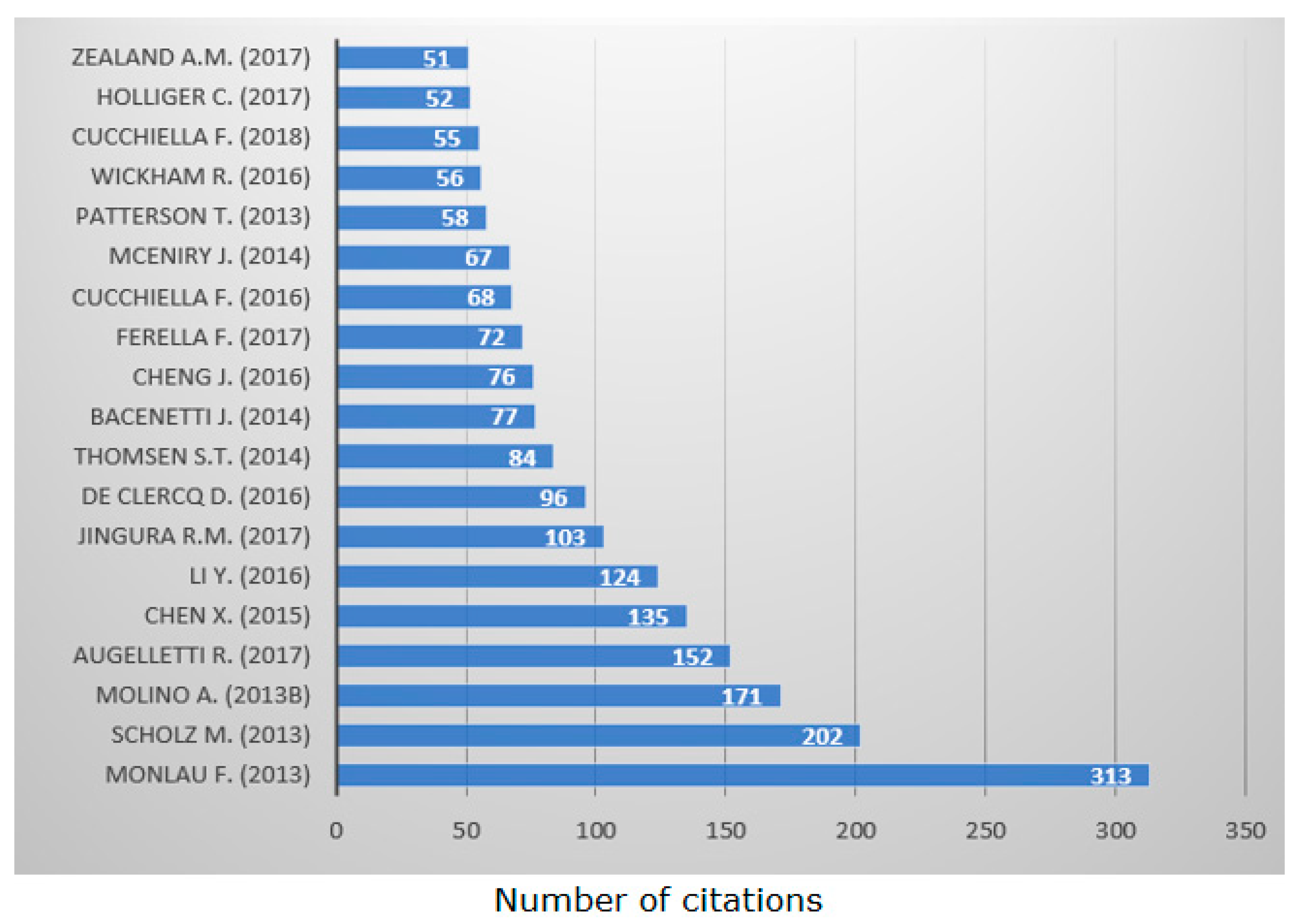
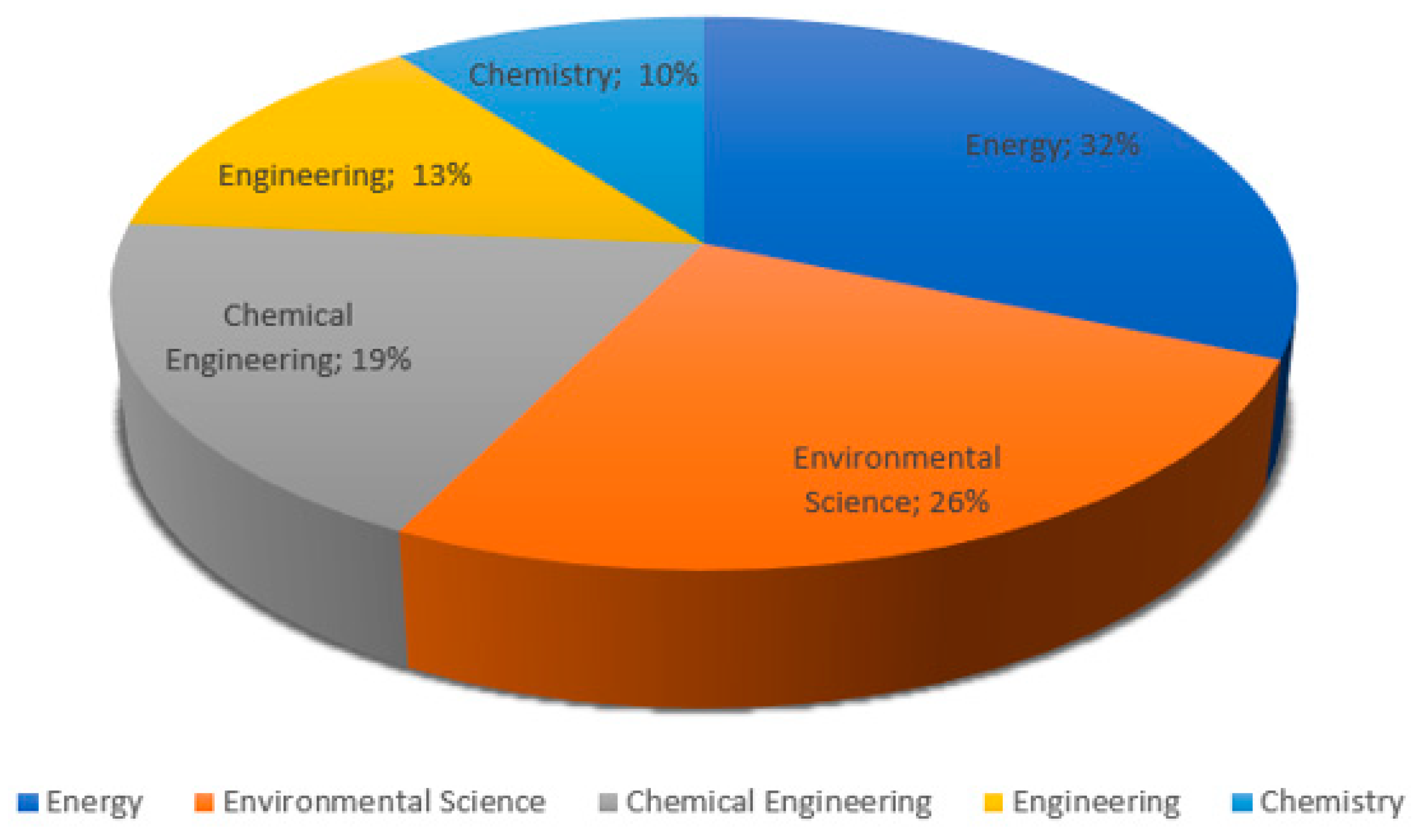
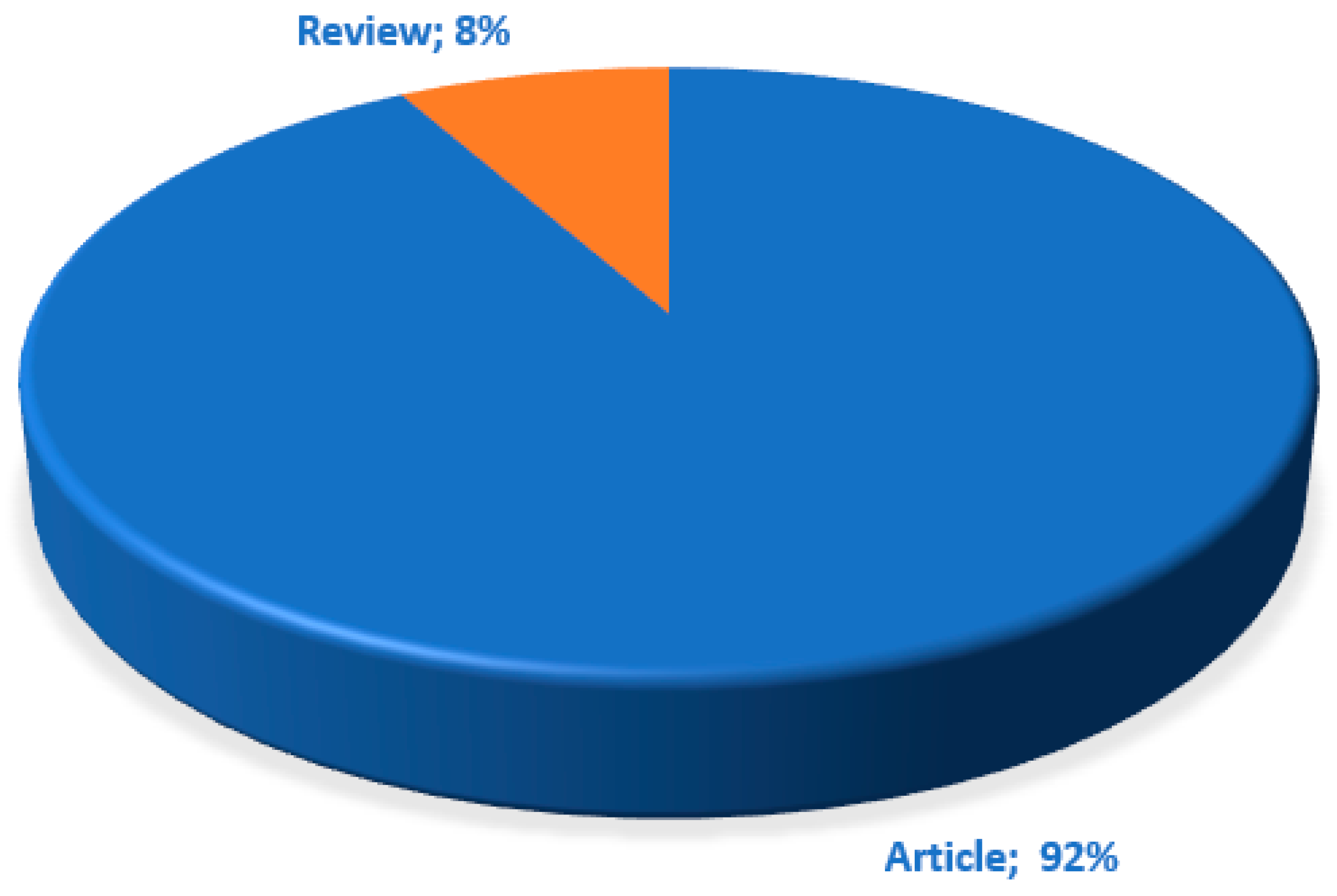
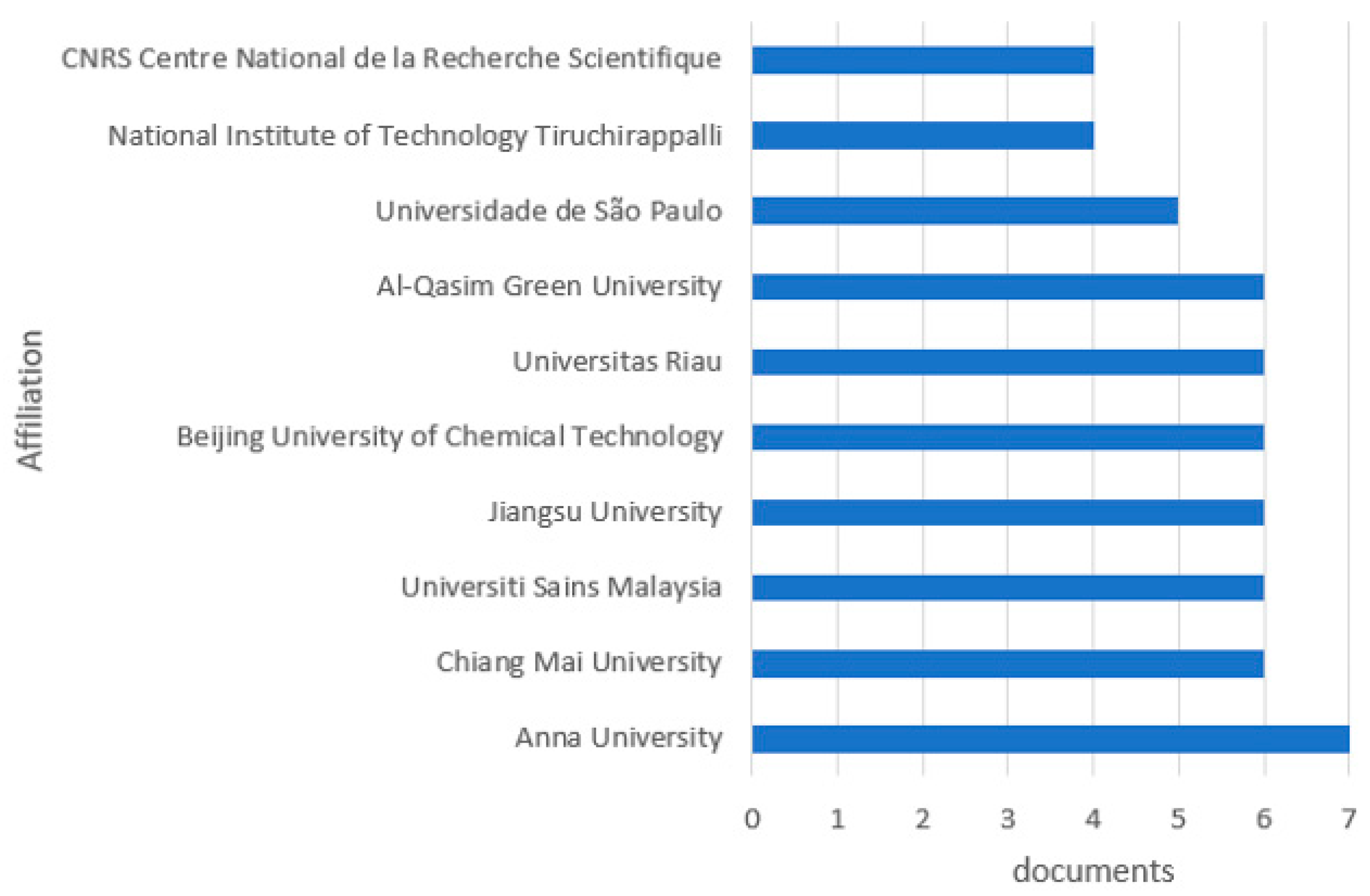


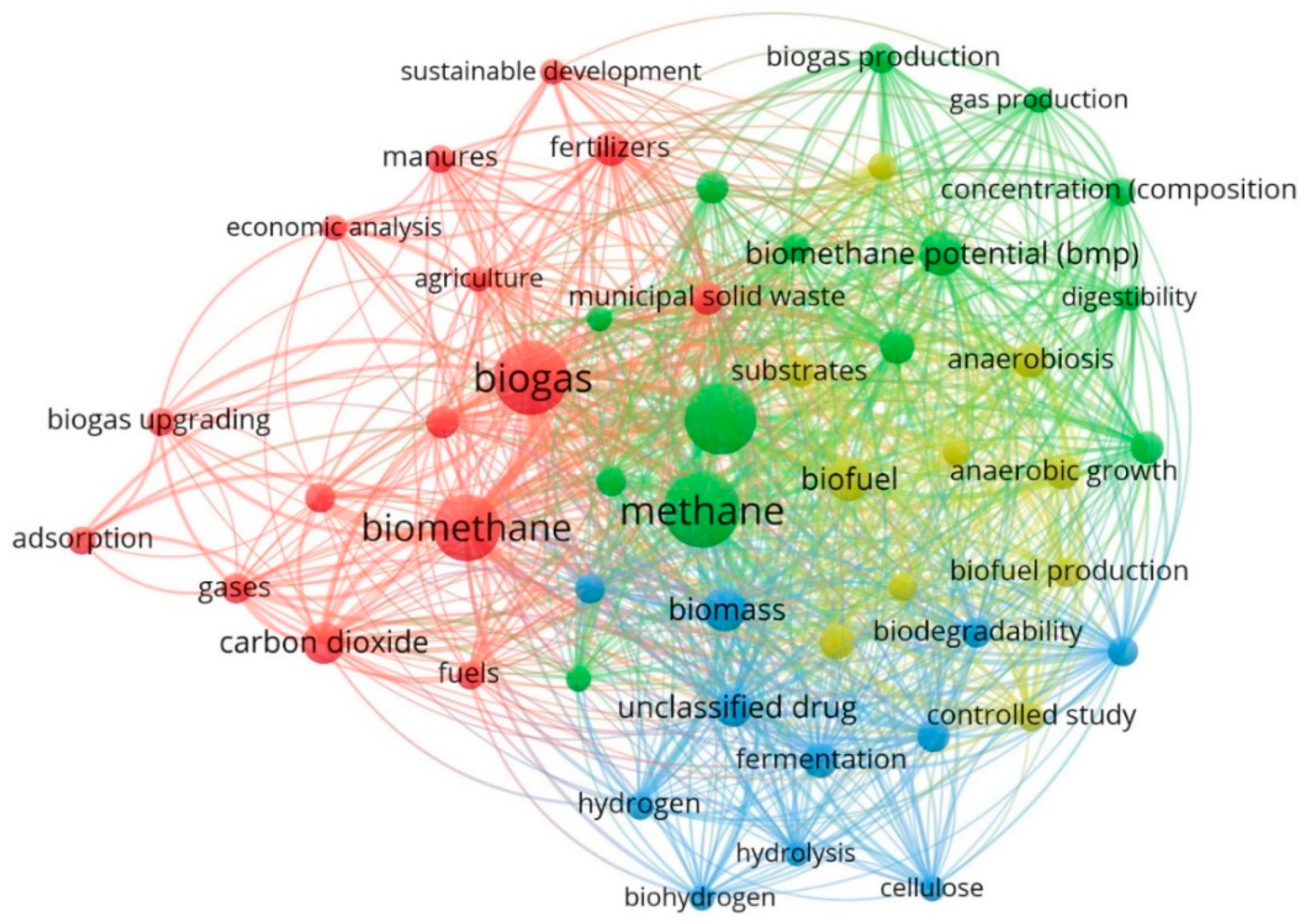

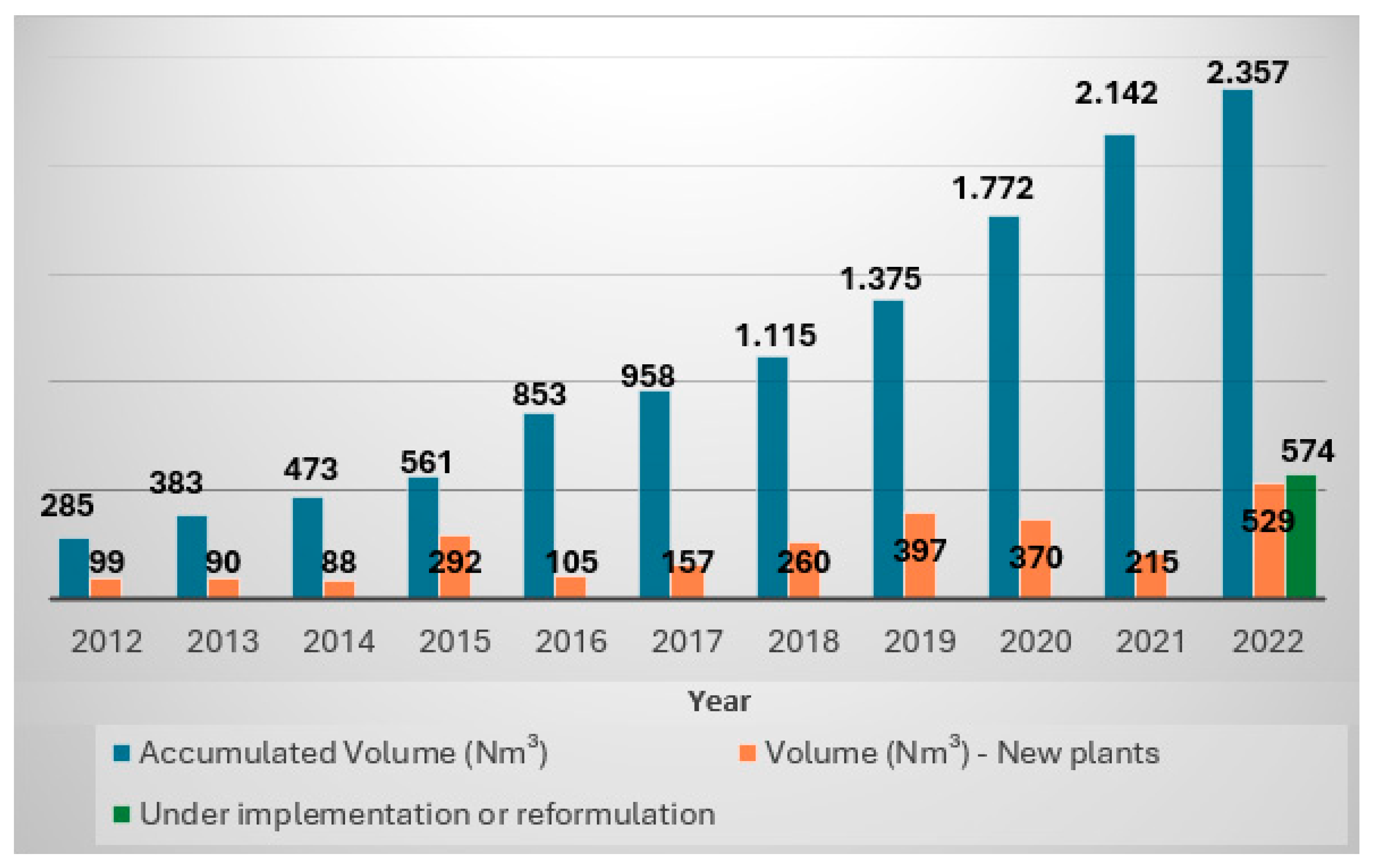
| Source | Description | Substrate |
|---|---|---|
| Agriculture | It involves animal husbandry activities such as poultry, cattle, pig and sheep farming, among others | Animal manure, effluent from waste management (urine, feces, washing water, etc.), feed remains, carcasses of dead animals that have not been slaughtered, among others. |
| Industry | Includes slaughterhouses and slaughter houses, sugar and ethanol plants, starch and starch factories, breweries, vegetable oil, gelatine, among others. | Industrial effluent and other organic waste from the industrial process. |
| Sanitation | It includes sanitary landfills, organic waste treatment plants and sewage treatment plants. | Urban solid waste (MSW) deposited in landfill, MSW segregated at source (organic fraction), fruit and vegetable waste, food waste, supermarket sanitary sewage. |
Disclaimer/Publisher’s Note: The statements, opinions and data contained in all publications are solely those of the individual author(s) and contributor(s) and not of MDPI and/or the editor(s). MDPI and/or the editor(s) disclaim responsibility for any injury to people or property resulting from any ideas, methods, instructions or products referred to in the content. |
© 2024 by the authors. Licensee MDPI, Basel, Switzerland. This article is an open access article distributed under the terms and conditions of the Creative Commons Attribution (CC BY) license (https://creativecommons.org/licenses/by/4.0/).
Share and Cite
Machado, M.V.d.S.; Ávila, I.; de Carvalho, J.A., Jr. Bibliometric Analysis of Renewable Natural Gas (Biomethane) and Overview of Application in Brazil. Energies 2024, 17, 2920. https://doi.org/10.3390/en17122920
Machado MVdS, Ávila I, de Carvalho JA Jr. Bibliometric Analysis of Renewable Natural Gas (Biomethane) and Overview of Application in Brazil. Energies. 2024; 17(12):2920. https://doi.org/10.3390/en17122920
Chicago/Turabian StyleMachado, Mônica Valéria dos Santos, Ivonete Ávila, and João Andrade de Carvalho, Jr. 2024. "Bibliometric Analysis of Renewable Natural Gas (Biomethane) and Overview of Application in Brazil" Energies 17, no. 12: 2920. https://doi.org/10.3390/en17122920








